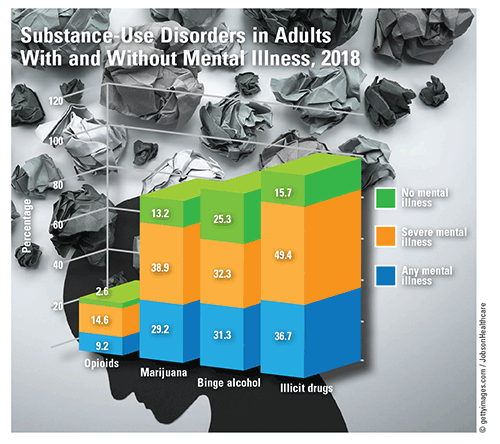US Pharm. 2019;44(11):15.
According to the Substance Abuse and Mental Health Services Administration’s 2018 national survey, substance-use disorder (SUD) is more common in adolescents and adults with mental illness than in those without it. Of the 164.8 million persons in the United States aged 12 years and older with an SUD, 31.9 million used illicit drugs and 1.2 million were binge drinkers. Among adults, 9.2 million had any mental illness (AMI) and an SUD, and 3.2 million adults had co-occurring severe mental illness (SMI) and an SUD. The proportion of adults using illicit drugs was significantly higher in those with SMI (49.4%) and AMI (36.7%) than in those without AMI (15.7%).

Substance Use: Of the more than 2 million adolescents who drank alcohol, 1.2 million were binge drinkers. Compared with the 25.3% of adults without AMI who were binge drinkers, 31.3% and 32.3% of adults, respectively, had AMI and SMI. Adolescents who had a major depressive episode (MDE) were more likely than those who did not to binge drink (8.5% vs. 4.1%) and use an illicit drug (32.7% vs. 14%). Almost 13% of persons with an SUD began using marijuana by age 14 years. In 2011, substantially more adolescents aged 12 to 17 years received treatment for marijuana use than for alcohol use (65.5% vs. 42.9%); the reverse was true for adults. Persons with SMI were 3.5 times more likely than controls to use marijuana regularly and 4.6 times more likely to use other drugs.
Treatment: Seventy-five percent of all treatment facilities performed screening for mental-health disorders, and 53% provided comprehensive mental-health assessment or diagnosis. Of adolescents with a co-occurring MDE and SUD, 5.4% received both mental-health care and specialty substance-use treatment, 59.5% received only mental-health care, and 0.8% received only specialty substance-use treatment. Of adults with co-occurring AMI and SUD, more than 51% received either mental-health care or specialty substance-use treatment; nearly 49% received neither. Close to 70% of adults with co-occurring SMI and SUD received either type of care, and more than 30% received neither. Substance-abuse counseling was provided at 94% of facilities, but strategies for relapse prevention were offered by only 87%.
Characteristics of Facilities: Of all facilities offering services for SUD, 36% more private centers were nonprofits than were for-profits (52% vs. 38%). While 77% of private nonprofit centers provided outpatient care and 31% provided nonhospital care, 89% of private for-profit centers offered outpatient care and 15% offered nonhospital care. In 2018, nearly 66% of adolescents with a co-occurring MDE and SUD received substance-use treatment at either a specialty facility or a mental-health service facility.
To comment on this article, contact rdavidson@uspharmacist.com.





